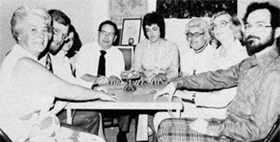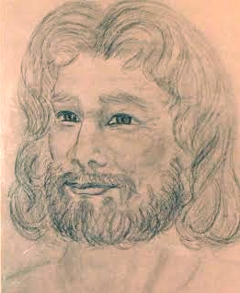The Philip Experiment
Philip wasn’t a real ghost. He was created from the imaginations of a group of Canadians to see if they could get traditional “spiritual” séance phenomena without a spirit.

Iris Owen (on left) and the other seven members of the Philip experimental group
The group consisted of an accountant, an engineer, an industrial designer, a scientific research assistant and four housewives, none of whom claimed mediumistic abilities. George Owen advised them and oversaw the experiments but didn’t sit with the group.
THE CREATION OF PHILIP
They decided that they’d have to invent their own ghost, someone who had never really lived, to answer their questions. One member made up Philip’s life story, a romantic tragedy casting him as a 17th century English Catholic, unhappily married, in love with a gypsy whom his wife accuses of witchcraft. He fails to protect her; she’s burned at the stake, and he throws himself off the battlements of his manor.

Drawing of Philip done by one of the sitters
PHILIP GROUP HAD NO LUCK AT FIRST
They started by sitting in a circle, sometimes around a table, the room illuminated only with candles or colored lights, and meditated. They met regularly once a week for a year, but nothing of real value happened.
Then Iris read the Batcheldor reports and the group, which was by this time a close-knit unit, decided to copy the methods used by the British researchers with a few variations. They opted against sitting in darkness; instead they used colored lights behind a sheet of frosted glass.
BATCHELDOR’S METHODS TRIED
They found it hard at first to relax and converse normally and were self-conscious about singing. But the sessions became less forced and they found it easier to tell jokes, recite poetry, or just chat while intending to produce “Philip.”
The change paid off. During the third or fourth new session they felt a vibration in the top of the table. Because of the noise they were making they weren’t sure they heard anything but were sure they “felt” a rap. As the sitting proceeded more raps occurred, more strongly and louder until there was no doubt in their minds. Then to their surprise, the table started to slide about quickly and randomly. It slid away so quickly that they had difficulty keeping up with it.
While they were speculating out loud about the cause, one woman said, “I wonder if by chance Philip is doing this?” There immediately came a loud rap from the table top.
COMMUNICATING WITH PHILIP
They adapted to the new situation using one rap for yes, two for no. Philip had not materialized but they had successfully obtained phenomena in full light with a “non-mediumistic” group. Even though “he” wasn’t a real spirit, they were interested in what he had to say.
Sitting around an ordinary folding card table, they’d start the session by each saying, “Hello, Philip.” A rap would occur under the speaker’s hand, the raps moving around the table to answer the person addressing Philip.
PHILIP’S PERSONALITY?
The table would sometimes rush across the room to “greet” a latecomer. If they got into a conversation that seemed as though they forgot him temporarily, Philip would demand their attention with a series of raps, or the table might suddenly slide across the floor.
The raps were varied. If they made a remark concerning Philip’s “wife,” Dorothea, they got extraordinary scratching sounds from underneath the tabletop. A good joke might elicit a loud series of raps giving a “rolling” effect as though the table was laughing. And as they sang favorite tunes, they’d get loud raps keeping time to the music.
ANSWERS TO QUESTIONS REFLECT SITTERS MINDS
The sitters asked “yes” and “no” questions about Philip’s life and received the answers they would have expected. They were correct when the group knew the facts but historically incorrect when they were unsure or ignorant of them.
For instance when he was asked if he enjoyed going to chocolate houses in London he gave a hearty “yes,” but chocolate wasn’t known at that time and chocolate houses weren’t introduced until more than a century after Philip’s “death.” Another time Philip responded “yes” when asked if the king loved cats. This was not historical fact but the person who asked had an ardent love of cats.
PHENOMENA ESCAPE THE SÉANCE ROOM
As in the Bindelof sittings, individual members of the group started experiencing poltergeist-like happenings in their homes. It seems that once the “energy” is started, it may be difficult to contain it to the sittings; it may break out from the subconscious in various ways.

Dr A.R.G. (George) Owen (1919-2003). Advisor to, and observer of, the Philip Experiment
Lights in their séance room would flicker with no known cause. They would ask Philip to “flick the lights” and there would be immediate compliance. One time a red bulb in their light panel switched off, leaving a level of light more pleasing to their eyes. They found nothing wrong with the bulb and no one had gone near it to turn the control knob.
GRAVITATIONAL FIELD CHANGE?
Philip was able to cause objects to stick to the table top in much the same way that D.D. Home had done when he caused a table laden with china and glass to tip and nothing fell off.
The Toronto group always “shared” candy with Philip by putting one piece on the table for him. Someone teasingly made a move to take “Philip’s” candy, telling him to hang on to it. The table was tipped to a 45-degree angle but the candy didn’t move. They tested this effect with other candies and all of them stayed put. Subsequently they manually tipped the table and at much less than the 45-degrees and the candies slipped right off.
DAMAGING THE PHILIP’S GROUP RAPPORT?
When someone said jokingly once, “Philip, if you won’t talk to us, we can send you away and get somebody else,” the raps ceased altogether. The group felt that the threat had disturbed their rapport. They knew from the Batcheldor work that they had to have complete faith in their ability to produce the phenomena. They resolved not to threaten Philip again. It took them most of that evening to coax his raps back again.
NO PARTICULAR MEDIUM IN PHILIP GROUP?
Because of a cold and flu epidemic that caused members to miss some sessions, the Philip group discovered that they could get the phenomena with as few as four people attending. Any four would do. If the quartet was feeling tired or perhaps coming down with an illness, the raps and movements would be weak but they still occurred. They never identified a single person who might have been a central indispensable member of the group.
I’ve wondered if the fact that there was no one very psychokinetically gifted member there might account for the lack of more spectacular phenomena being produced.
CAPTURING PHILIP ON TAPE AND TV
They recorded many sessions by taping a microphone under the tabletop and were able to capture table movement and raps on a video during a Canadian TV show on which they appeared. (Below is a link to the show in which you can hear the raps and see the table tilting and turn over on its back.) They claimed to have achieved full levitation with all four legs and inch or so off the floor for a very short period, but I believe there is no record of that on tape.
Amazingly, this all took place in front of a large studio audience and under glaring TV lights!
The Philip group did not get the materialization they had originally sought, nor did they get the more spectacular manifestations that D.D. Home, Palladino, Kluski and others did. The question is why? [I will explore this question in the “Commentaries” section]
Dr. Owen and the group concluded that phenomena could indeed be elicited by a like-minded group and that the force arose from the combined focus of the group on one object. They also agreed that Philip’s personality was formed from their own, since they created him.
Neither the Owens nor the group’s members knew of the Bindelof sittings that preceded theirs by about 40 years because that remarkable group had not been publicly reported upon. As today’s readers can see, both Philip and Dr. Bindelof had much in common.

Clips of Philip group, interviews with Iris Owens, Philip’s Canadian TV show debut:
Read about other “outside the séance” people:
Felicia Parise • Gilbert Roller • Kenneth Batcheldor • Nina Kulagina • Sir William Crookes
Ted Serios • The Philip Experiment • Uri Geller